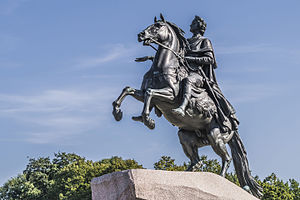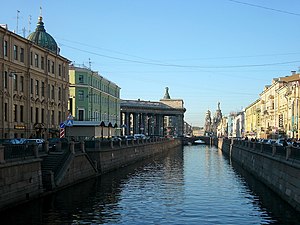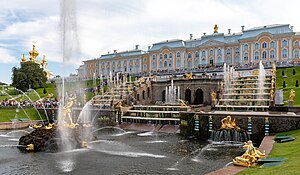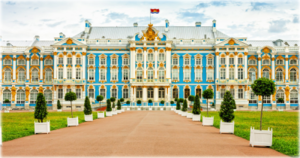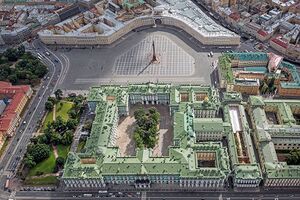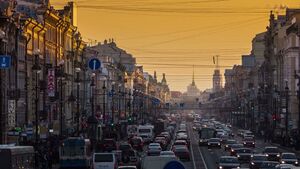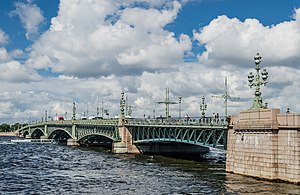Sangur, Gabrielland
Sangur | |
|---|---|
| City of Sangur Sngōreh Kzamā | |
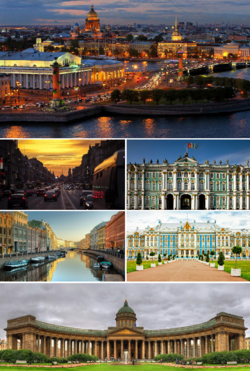 Clockwise from top: Skyline of Sangur, Arsyan Parliament, Sangur city hall, Hgaztak monument, East Sangur canals, Addarti Road | |
| Nickname: "City of a thousand rivers" | |
| Motto(s): "Klōmeh Gzit, Aršēhē Mzol" ("Pride of Kalamar, Soul of Arsya") | |
| Country | |
| Region | Arsya |
| Province | Arsya |
| Government | |
| • Mayor | Lohmmi Tāgār (PDA) |
| Area | |
| • Capital city | 217.9 km2 (84.1 sq mi) |
| Elevation | 8 m (26 ft) |
| Population (2020) | |
| • Capital city | 2,701,304 |
| • Metro | 4,814,815 |
| Demonym(s) | Azongur (m), Azēngēr (f) |
| Time zone | UTC-3 (GST) |
| Postal code | 7 |
| Area code | 381 |
| Vehicle registration | R/(A-R) |
Sangur (Arsyan: [ˈsɑŋkʏr], Gabrielt: [saˈŋʊr]) is the capital city and largest city of the Kingdom of Arsya, both in term of area and population. With a population of 2.7 million people, it is the third largest city by population in Gabrielland and makes it one of the most populated cities in the Dokodo Union. The city, along with several satelite cities, form the Sangur metropolitan area, home to 4.8 million people or about 15% of the population of Arsya. It is also the administrative center of the region and province of Arsya, making it the administrative center of three different administrative levels. The city is bordered by the Arsyan sea to its east, Včin municipality to its north and west, as well as Kazogur municipality to its south.
The city was first documented as Margandda in an early Arsyan manuscript from the 8th century AD, where it served as the capital of the Kingdom of Junram. The importance of Margandda grew during the consolidation of the Tahkki kingdom in the late 11th century AD, when the city was conquered by the invading forces and made the capital of the Tahkki kingdom. In the early 14th century, a group of Arsyan kings hired mercenaries from Anderum to beseige the capital of Tahkki and take control of the surrounding lands. In 1308, the seige was declared a victory, although pyrrhic, and the mercenaries promptly renamed the city into Sangur as an homage to the Sangur back in Anderum. It became the capital of the Arsyan confederation, then the Arsyan kingdom, and finally the realm of Arsya in modern-day Gabrielland, with Sangur also serving as the capital of the short-lived Arsyan Republic between 1976 and 1985.
Sangur is a world city of culture, politics, and media. The economy of Sangur is mainly based on high tech firms, institutions, and coroporations, encompassing a diverse and sundry forms of service, manufacture, and goods, with the bulk of Gabrielland's startup and high-tech research facilities mainly located in Sangur. Sangur also serves as the railway and air hub of northern Gabrielland, and also serves as the capital of the Gabrielt automotive union. The downtown of Sangur is also a world-heritage site, as it preserve the buildings, canals, and landscape presented in the Arsyan Baroque style from the 18th centuries, a style which is still popular in Sangur today.
Renowned universities within Gabrielland are located in Arsya, including the Arsyan Institute of Science (AIS) and the Royal Arsyan University (RAU), the oldest university in Arsya. The city has numerous museums, parks, monuments, and historic buildings, with the most famous ones being the Arsyan Parliament, the city hall, and the Hgaztak monument. The Arsyan People's Zoo is the largest zoo in Gabrielland, and is frequented by visitors, with a record high attendance in 2019.
History
The history of Sangur could be first attributed to the documentation by classical Arsyan scribes from the Junram Kingdom, in which the city was said to be named after King Margandda II of the Malarri Kingdom, to which it served the capital of the entire kingdom from the rise of the Junram dynasty to its fall to the Tahkki Kingdom in around 1086 AD. Remnants of houses and buildings have been dug up near the banks of the Kalamar river near the sea along with several household items and housewares dating back to the early 8th century, further strengthening the writings from the Junram Kingdom.
The city would change hands multiple times in history, with the Tahkki Kingdom seizing the city and repurposing the city as the capital until being besieged by mercenaries from Anderum in 1308, when the city was declared a city state in the Margandda treaty of 1308, then renamed into Sangur. It served as the capital and political hub of the Arsyan confederation during its concpetion in the late 17th century, then becoming the royal capital of the Arsyan Kingdom in the 19th century, until its incorporation into Gabrielland and Arsya where it retained its capital status for the Kingdom of Arsya, however no longer a national capital.
Early beginnings
The earliest piece of evidence found to indicate the existence of an ancient city within the grounds of present-day Sangur was unearthed in 1981, when a park was excavated near the Arsyan parliament in the city center to unearth a fully-intact house filled with various sorts of household items and objects, carbon-dated to be from the early 8th century. In the manuscripts, the city was described as being the city of Margandda, serving as the capital of the Junram Kingdom. Subsequent excavations in nearby locations unearthed more social places such as markets, shops, and boutiques from the era.
Given the importance of the city, both for its already huge population even for classical Arsya and its strategic location at the banks of the Kalamar river near the mouth, the city was highly contested by neighboring kingdoms and duchies. Early defence strucutres such as towers and walls were at least known since the times of the Arsyan confederation, however were not attributed to the Junram Kingdom. The old city walls of Margandda is the dividing line between the old downtown of Sangur and the rest of Sangur, and also the world heritage side in modern applications.
Tahkki Kingdom
In 1085, the Tahkki Kingdom invaded the Junram Kingdom and incorporated into their territory as a vassal, however, the surrounding areas of Margandda were kept as an integral part of the kingdom and was made the capital, moving the capital from Vratama. The Tahkki Kingdom, with its larger size both in population and area, brought tremendous changes to Margandda, revamping and renovating the city to fit the needs of a capital city worthy of a kingdom the size of Tahkki. In 1138, the first well-preserved building in Sangur was built (Gaztur's tower), and was a sign of an early attempt at urban renewal done by city authorities at the time.
The city limits of Margandda kept expanding in response to the ever increasing population coming from all over Tahkki, and by the late 12th century, the city was recorded to have a population of 100,000 people, a massive size for the time. Numerous protests were recorded against the Tahkki Kingdom for bad urban planning and sanitation, which led to the 1207 plague of Arsya, killing every third Arsyan and half of Margandda.
In 1308, the city was besieged by Anderic mercenaries hired by other kings in Arsya to reclaim the capital from the Tahkki kingdom. Upon the success of the siege, the city was renamed into Sangur and was declared a city state which served as a neutral economic hub for many kingdoms that the Kalamar flowed through.
Arsyan Confederation and Kingdom
Upon the creation of the Arsyan confederation in the 17th century as the coordinating body and alliance between Arsyan-speaking staes, the neural city state of Sangur was made the capital of the Arsyan Confederation as it was seen as a neutral compromise between states as well as an economically prospering city, providing the basic foundations for a capital. Upon designation as capital, Sangur was renovated and refurbished to repurpose it as the capital for all Arsyans in case a kingdom or empire was to be set up comprising of all the Arsyan sates of the confederation as nationalism and pan-Arsyanism had been growing over the past few decades leading up to the creation of the Arsyan confederation.
As a result of being located in lowlands and marshy groudnds, Sangur flooded frequently, with seasonal floods being commonplace throughout the Kalamar river. In the early 18th century, massive canals and waterways were constructed in Sangur at the behest of the confederate agreements. These canals would divert water flow through a variety of channels and streams to ease the flow of water during rainy season or the sort. As a result, many houses were demolished to make way for these canals, however as another side effect, the first public housing estates and compounds were constructed in Sangur in the Arsyan baroque style prevailing throughout Arsya at the time. The public housing built in the Arsyan baroque style proved popular, and the city sought to refurbish all buildings to fit in the style.
The declaration of the Arsyan Kingdom also meant the declaration of Sangur as its capital, as many would expect. During the reign of the Arsyan kings, Sangur was heavily invested in by royals to beautify the city in an effort to transform Sangur into a city fit for a capital and the center of Arsyan exellence, art, and beauty. Sangur gained several new landmarks and buildings under the Kingdom of Arsya, such as the Sangur city hall, Arsyan parliament, and possibly most noted is the Riehtto palace built in 1824 as the residence of Arsyan kings.
Sangur became a focal point in the struggle for the Arsyan-Gabrielt unionist movement. Many unionists first voiced their support for the union in Sangur as early as the 1910s upon the talks between the Gabrielt and Arsyan delegations in Sangur. Sangur would eventually become the site of a massive protest against the imperial Arsyan government, leading to the union of Gabrielland and Arsya in 1926. The act of union (1926) was also signed in Sangur.
Modern Gabrielland
Sangur would continue to become the capital of the Arsyan realms, as well as become the new economic capital of Gabrielland.
In 1976, the city became the capital-in-exile of the legitimate Gabrielt and Arsyan government after Dzakwanist forces seized control of Vailhims on the 11th of February 1976 and declared Dzakwanist Gabrielland. Six days later, the old government proclaimed a new Gabrielt and Arsyan Republic with Sangur as its capital-in-exile, however, by 1977 the name was scrapped and the Arsyan Republic was proclaimed by the government to maintain international recognition of the Gabrielt state. Sangur became the capital of the Arsyan Republic between 1977 and 1985.
In 1985, Sangur was declared the economic capital of Gabrielland after constitutional amendments were enacted on the 1st of March 1985.
In 2001, the port of Sangur was inaugurated, serving as the hub of Gabrielt export and import activities.
Geography
Topography
Being in northern Gabrielland and on the banks of the Kalamar river, the land around the city is fairly flat and low lying surrounded by marsh, itself being part of the greater east Arsyan lowlands. The low lying region situated by the banks of a tidal river causes some of the worst floods to occur in Arsya and Gabrielland as a whole. Although low lying, several city districts mainly located further upstream are situated on the Mzermek hilly region, an abnormal uplift of land which stretches into central and south Arsya. The districts closest to the sea, however, have fallen under sea level since at least the late 1700s, and is a primary reason of the construction of Sangur's famous canal and waterway system.
The tallest point in Sangur city proper is the Mritas peak, situated in the Klizōr district at a height of 137.3 meters above sea level, situated far from the coast, while most of the historic downtown and seafront of Sangur have dipped below sea level, with the lowest point being situated at Pehssin square at 5.6 meters below sea level.
Climate
Sangur's climate could be described as oceanic (Cfb), with strong influences from the eastern winds blowing into Arsya as a whole. Sangur has mild summers and cool winters, with snowfall occurring during winter months at varying rates of precipitation throughout the years. Due to the relatively low latitude of Sangur, summers are not that extreme and winters not that rigorous, although occasional blizzards and heat waves still occur, although affecting not only Sangur but the majority of Arsya too.
Summers are warm and somewhat humid with a mean of 19-20°C, a high of 26°C and a low of 14°C, with the average precipitation during summer months being rain at around 67.31 mm of rain during the months of June-August. Winters are cool with a daily mean of around 4°C, a high of 7°C and a low of -3°C to 0°C.
| Climate data for Arsyan Royal Observatory, elev. 19 m, 1979-2015 | |||||||||||||
|---|---|---|---|---|---|---|---|---|---|---|---|---|---|
| Month | Jan | Feb | Mar | Apr | May | Jun | Jul | Aug | Sep | Oct | Nov | Dec | Year |
| Record high °C (°F) | 15.5 (59.9) |
18.1 (64.6) |
24.3 (75.7) |
29.9 (85.8) |
34.5 (94.1) |
35.7 (96.3) |
37.3 (99.1) |
38.1 (100.6) |
33.1 (91.6) |
27.2 (81.0) |
21.5 (70.7) |
16.6 (61.9) |
38.1 (100.6) |
| Average high °C (°F) | 4.5 (40.1) |
5.9 (42.6) |
9.1 (48.4) |
13.6 (56.5) |
18.1 (64.6) |
20.4 (68.7) |
23.5 (74.3) |
23.4 (74.1) |
18.7 (65.7) |
14.1 (57.4) |
8.3 (46.9) |
5.4 (41.7) |
14.3 (57.7) |
| Daily mean °C (°F) | 2.1 (35.8) |
2.5 (36.5) |
5.8 (42.4) |
8.6 (47.5) |
13.6 (56.5) |
16.1 (61.0) |
18.6 (65.5) |
18.2 (64.8) |
14.8 (58.6) |
10.4 (50.7) |
5.8 (42.4) |
3.4 (38.1) |
10.0 (50.0) |
| Average low °C (°F) | −2.4 (27.7) |
−2.2 (28.0) |
0.1 (32.2) |
2.3 (36.1) |
6.4 (43.5) |
10.5 (50.9) |
13.7 (56.7) |
12.5 (54.5) |
11.6 (52.9) |
7.0 (44.6) |
3.4 (38.1) |
1.0 (33.8) |
6.7 (44.1) |
| Record low °C (°F) | −26.8 (−16.2) |
−31.1 (−24.0) |
−14.3 (6.3) |
−8.1 (17.4) |
−6.4 (20.5) |
1.5 (34.7) |
5.6 (42.1) |
4.8 (40.6) |
−1.4 (29.5) |
−5.1 (22.8) |
−14.4 (6.1) |
−21.5 (−6.7) |
−31.1 (−24.0) |
| Average rainfall mm (inches) | 77.9 (3.07) |
59.8 (2.35) |
77.9 (3.07) |
52.8 (2.08) |
67.5 (2.66) |
88.5 (3.48) |
86.7 (3.41) |
88.9 (3.50) |
77.4 (3.05) |
77.0 (3.03) |
79.2 (3.12) |
78.9 (3.11) |
912.6 (35.93) |
| Average rainy days (≥ 1.0 mm) | 13.1 | 10.2 | 13.3 | 10.1 | 9.7 | 12.4 | 11.4 | 10.2 | 10.8 | 10.5 | 11.7 | 12.4 | 135.8 |
| Mean monthly sunshine hours | 106.9 | 129.0 | 158.8 | 221.6 | 283.4 | 258.7 | 287.5 | 263.1 | 204.6 | 167.9 | 123.0 | 117.4 | 2,321.9 |
| Average ultraviolet index | 0 | 1 | 2 | 4 | 5 | 6 | 6 | 5 | 4 | 2 | 1 | 0 | 3 |
Demographics
| Historical population | ||
|---|---|---|
| Year | Pop. | ±% |
| 1700 | 130,000 | — |
| 1800 | 350,000 | +169.2% |
| 1900 | 730,000 | +108.6% |
| 1950 | 1,434,037 | +96.4% |
| 1960 | 1,557,393 | +8.6% |
| 1970 | 1,700,381 | +9.2% |
| 1980 | 1,920,483 | +12.9% |
| 1990 | 2,150,385 | +12.0% |
| 2000 | 2,347,594 | +9.2% |
| 2010 | 2,540,391 | +8.2% |
| 2020 | 2,701,304 | +6.3% |
According to the latest estimates, Sangur has a population of 2,701,304 as of 1 January 2020 living in an area of 217.9 km² with a density of 12,397 people per square kilometer. The Sangur metro area, which covers the municipality of Včin and Kasogur, contains a population of 3,814,815 people with an area of about 768.2 km², making it the largest metro area in Arsya and the second largest in Gabrielland, although it ranks low when compared to metro areas in other Dokodo Union member states. Sangur is also the largest city proper in Arsya.
The racial makeup of Sangur is increasingly becoming multi-racial. Arsyans make up the majority at around 91% of the population, with a majority of them being born within the city. Ethnic Gabrielts make up 6% of Sangur's population, a higher proportion when compared to Arsyans living in Vailhims (2%), with the rest made up of mostly Grafenlandish and people from all over the Dokodo Union. A sizeable minority of Junterlandish people also exist within the city.
Ethnic groups
| Ethnic Group | Number | % |
|---|---|---|
| Arsyan | 2,452,784 | 90.8% |
| Gabrielt | 159,377 | 5.9% |
| Grafelandish | 29,714 | 1.1% |
| DU citizens | 35,117 | 1.3% |
| Others | 24,311 | 0.9% |
Arsyans make up almost 91% of Sangur's population, followed by Gabrielts and Grafenlandish. Sangur has been inhabited by Arsyans since its founding with notable minorities including the Grafenlandish and the Bak people in the past. However, Sangur is becoming increasingly multi-racial with more Gabrielts and citizens from other DU member states moving into the city. Gabrielts make up 6% of the population, up from 4% in 2010. Many Gabrielts who move to Sangur are mostly internal migrants with no Arsyan blood or heritage seeking for employment.
In 1976, 10,000 Gabrielts, mostly politicians and their families as well as some businessmen, fled Dzakwanist Gabreilland and settled in Sangur which had become the capital of the Arsyan Republic. This marked the first great migration of Gabrielts into Sangur since the treaty of union in 1926. Their descendants today number in the tens of thousands and make up a sizeable portion of ethnic Gabrielts in Sangur, although many of them have married with Arsyans. Their descendants are no longer counted as Gabrielt, but Arsyan.
Languages
Arsyan is the primary language of education, commerce, media, administration and daily life in Sangur, as is with the rest of Arsya, however, most Arsyans are bilingual in both Arsyan and Gabrielt. All administration in Sangur, while in theory should be able to support both Gabrielt and Arsyan, is only conducted in Arsyan. Gabrielt is studied from grades 1-12 and as an elective in university as the "national language" of the nation.
Other languages spoken in Sangur mostly come from neighboring nations or other DU member states, with Grafenlandish, Kuronobean, and Bak being some of the most popular foreign languages in Sangur.
Government
Sangur is the capital of three separate administrative entities in Gabrielland, namely the Realm of Arsya (or Kingdom of Arsya), the Arsya Region as well as the Arsya province. As a result, four different governments base their operations from Sangur with the addition of the Sangur city government. The mayor of Sangur therefore has additional priviliges and authority when compared to other leaders at the same level, such as financing and policing issues. The mayor of Sangur is elected once every five years through a simple two round system.
Since the construction of the Sangur city hall in 1831, the seat of the Sangur city government has been based from the building, with the mayor's office, parliament and some public facilities being based from the building. Since the inception of the Gabrielt and Arsyan union, Sangur has always been government by a left leaning majority, with the PDP taking a huge portion of the share of mayors. Since 1975, Sangur has always been governed by a PDP mayor. Between 1990 and 2005, Sangur was led by Kiryan Tašrat, a strong advocate of democratic socialism and welfare. He was succeeded by Lohmmi Tāgār, who still is the mayor of Sangur until today. Elections will be held in October 2020 to select a new mayor for the next five years.
Divisions
The city is divided into 9 districts further subdivided into 79 quarters. The organization of Sangur was first codified into law upon the creation of the city of Sangur in 1926 by Gabrielt and Arsyan authorities. The number of quarters have increased, however the number of districts have remained the same. New districts have been proposed but have never been accepted due to a lack of real support from the population already living in those districts.
Districts are governed by district councils and led by a district mayor. District councils report to the Sangur parliament, while district mayor reports straight to the mayor. The districts, however, are not fully independent, and must follow the guidelines and instructions of the Sangur parliament. They are granted freedom in more aesthetic aspects of city management such as designs of various signs and parks, etc. The 9 districts are (in alphabetical order) Bihttir, Dēššmar, Klizōr, Manira, Pairēn, Rijē, Sangurom, Sulgub, and Zinttroh.
Cityscape
The cityscape of Sangur has been greatly influenced by both previous administrations and the quality of the land surrounding it. It was subject to massive renovations and urban renewals back in the 18th and 19th centuries, greatly due to an effort to improve the flow of the Kalamar river into the Arsyan sea with the construction of massive canals and waterways in the 18th century. The Arsyan confederation, who at that time made Sangur the capital of the confederation, ordered the total rehabilitation of Sangur, inviting professionals from abroad to help succeed their ambitions. During the total reconstruction of Sangur, Arsyan baroque architecture and its derivatives flourished, and became the primary style of buildings rehabilitated, many of which could still be seen today.
The Kingdom of Arsya also contributed its share to influence the cityscape of Sangur. During the height of monarchism in Gabrielland, Arsyan monarchs would spend massive amounts of the state treasury in constructing massive structures and buildings in the Arsyan baroque style, as well as renovating buildings across Arsya to fit in with the style of taste. Many famous landmarks, such as the Arsyan Parliament, the Sangur city hall as well as the Hgaztak monument were commisioned under the reign of Klirdis II in an effort to make Sangur a world-class city at that time.
High rises are strictly regulated and only permitted in certain areas of the city. The tallest building in Sangur is the Arsyan Trader's Union building at 155 m tall. Most buildings in Sangur are between 6-8 stories tall.
The cityscape of Sangur has been named by some to be "one of the most beautiful" in the world owing to its intact baroque architecture and waterways. It was visited by 12 million travellers in 2019.
Architecture
As a result of centuries of urban renewal, development, and preservation, most buildings today in Sangur are built and styled according to the principles of Arsyan Baroque and its counterparts, though the city as a whole possesses a variety and diverse forms of architectural styles and modes. Government buildings often serve as important landmarks across Sangur as they are usually decorated and built very ornately, with the most famous examples being the Arsyan Parliament and the Sangur City hall located in downtown Sangur.
Sangur also possesses many canals and waterways as a side effect of the normalization of the Kalamar river done in through the 17th and 19th centuries. These canals serve as a means of transport for some residents as well as a recent influx of tourism from the canals itself. Consequently, Sangur has many bridges with around 2,000 or more bridges according to the ministry of public affairs. The Valkki bridge and Pehssin bridges are probably the most famous bridges in Sangur, crossing the delta of the Kalamar and in full view of the city.
The Sangur city hall is an ornate and richly decorated building located in the Sangurom district finished in 1848 on the behest of the Arsyan Kingdom. The grand symmetry of the building with the grand scale of the whole complex adds in to the appeal the city hall has to offer, with 3.8 million people visiting the city hall as tourists or sightseers. The Arsyan parliament located not far from the city hall is also richly decorated in the Arsyan baroque style and possesses symmetry crucial to Arsyan baroque design.
Many of the residential buildings in Sangur are in the form of apartments, while houses and larger spaces are reserved for the suburbs. The residential buildings dominate the outskirts of Sangorum (downtown Sangur), most also designed and styled in the Arsyan baroque style albeit with more plain colors and less complex of a design than more official buildings or landmarks. The residential buildings usually possess six to eight floors of space with the roof acting as a general storage space for residents. Many shops are also styled and renovated after the city's general style.
More modern developments and buildings have began being built and constructed in Sangur, however with very heavy restrictions. The city center and surrounding districts may not be altered in any way architecturally, and glass buildings must be approved by the city council and populace, with many of the accepted plans being located near the outskirts of Sangur. The most recent example of a skyscraper being constructed in Sangur is the Arsyan Traders' Union at 155 m tall completed in 2017, albeit after much protest and opposition from the local populace.
The city also has a large number of parks and gardens scattered throughout the city, however, Sangorum contains the most green space of any district in Sangur. Various themes and styles of parks are present throughout the city, and parks styled after those of other nations are not uncommon in Sangur. The largest greenhouse in Gabrielland, the Sangur greenhouse, is located in the Dēššmar district, containing a huge amount of plants and flowers to be preserved in its own climate different from Sangur.
Parks and gardens
The massive and lush Sangur botanical gardens serve as the city's prime garden and park for its residents. The Sangur botanical gardens cover an area of 1.2 square kilometers in the Dēššmar district and features a wide variety of plants, trees, shrubs, flowers, and vines. The maze of Gilmar, one of the largest natural mazes in Gabrielland, is located within the confinemnets of the Sangur botanical gardens, and is a popular spot for picnics and family gatherings for not only Sangur residents, but the entire realm.
Besides the Sangur botanical garden, there are other parks of various sizes and themes scattered throughout Sangur, providing fresh air for the residents of the city. These parks usually contain fountains as a mark of Sangur's mastery over water. Parks are maintained by the Sangur department of forestry and parks.
Public squares and places
The city has 3 main squares, the largest being the Blue Square, the site of the proclamation of the Arsyan Kingdom. The square is located in the historic center of Sangur, where most vehicles are banned from entering. The square is connected to the main shopping street free of vehicles, and is a popular place for tourists to go shopping and experience the city as a whole. In the center of the Blue Square is a monument towards the Arsyan people named the Return of the Arsyans into Nobility. It is possibly the most recognized symbol of Sangur, and is depicted in mnay postcards originating from Sangur. The Blue Square is mostly used for a variety of festivals both seasonal and religious, and in 2015 was used for the concert of K.L.K.T, containing 50,000 within the single square.
The Milrin Square located not far from the Blue Square is also an important square in Arsyan history.
Culture and contemporary life
As the capital of the Arsyan realm, Sangur also serves as the cultural capital of the Arsyan peoples, with many Arsyans of various backgrounds and cultures all settling within Sangur, bringing with them their original cultures. Sangur is a melting pot of Arsyan cultures, and is evident with the various traditions exclusive to Sangur which combines many of the individual elements of different Arsyan groups and clans into one grand festival or occassion, most notably the Sangur founding festival.
As of 2015, there are more 25 theaters, 120 museums, and 200 music venues, clubs, and institutions. Institutions operating these buildings, both government and private, contribute a great amount into the Sangur city budget every year, with more than 12 million visitors in 2019. Sangur has overtaken Vailhims as the most visited city in Gabrielland as of 2017, and is predicted to increase due to its growing connectivity and ease of transport into and around Sangur. Music venues and night clubs have also become more popular recently with the influx of outside culture, and many exprets are concluding that Sangur is currently experiencing a night life renaissance.
Museums
There are over 120 museums in Sangur. The major ones are art galleries showcasing classical, medieval, renaissance, romantic, and contemporary art. King Rahtti II museum and gallery is the most notable museum in Sangur, showcasing over 600 paintings, sculptures and other works of arts within its space. The building itself is also considered a historic work of art as it was one of the earliest implementations of Arsyan baroque. Several other more dedicated museums exist in Sangur, such as the Sangur National Archaeological museum depicting historical and archaeological finds from Arsya and Gabrielland. The Irkking Museum depicts the entire history of both Gabrielland and Arsya and its struggles throughout the century, often frequented by schoolchildren. One other notable museum in Sangur is the Sangur Turd Museum, which showcases various excretement of a diverse set of animals.
While not considered a museum, the Sangur Botanical Gardens also showcases a massive amount of plants, trees, and other flora both native and unnative to Sangur or Arsya.
Music
The music industry and culture in Sangur is one of the most developed in Gabrielland. There are more than 200 music venues, clubs or institutions operating in Sangur complemented by at least 5 operas, the largest being the Sangur state opera, home to the Sangur city phillharmonic orchestra. The city also has other operas and concert halls, such as the Altrikka playworks, the oldest opera in Sangur dating back to the late 17th century. In addition to operas, Sangur has two main concert halls, the larger one being the Sangur music park grounds. The Sangur music park has seen various concerts, tours, and symphonies performed there, and is one of the most important music icons of Gabrielland as a whole.
The city is also renowned to be the birthplace of many renowned and famous bands both domestically and internationally, such as DviGira, K.L.K.T, Prinntih, and the Sanguriettes, as well as many influential singers such as Gillrin Tammbiro, Vallizas Akkuri, and Hannah Ohmmi. Various genres and themes of music are also present in the city, with singers such as Gollvi Tinnir famous for hard rock and metal, the Killrins for their R&B, and various other artists. There are approximately 793 registered bands or singers in Sangur as of 2016, making it one of the highest per capita in Gabrielland.
The production of various musical films and plays in Sangur has increased within the past decade. Ever since the filming of the first musical drama film in 1993 titled "A Songbird's Dream", the musical industry has played a much bigger role in filmmaking and cinematography. The most successful musical drama film in Gabrielland to date was filmed in Sangur, grossing over 23 million Gabiros over the course of three months of running.
The Gabrielt and Arsyan Hall of Fame is also located in Sangur. The building, built in a post-modern style, hosts the Gabrielt and Arsyan musical hall of fame, where Gabrielt and Arsyan artists are inducted upon being granted the title for their great contributions towards the development of Gabrielt and Arsyan music culture. Currently, there have been 184 inductees in the hall of fame, with personal spaces and stars for every artist inducted into the hall of fame. The hall of fame was completed in 1998.
Sangur is also the birthplace of Arsyan pop, a style of music which combines elements of traditional Arsyan music with more modern elements and beats, creating a unique blend of the two musical systems.
Legendary composer Ilhar Tirrin was also born and raised in Sangur, having completed many of his works and performances in the city too.
Cuisine
As the melting pot of various Arsyan clans and groups, the cuisine present in Sangur is rich and varied with elements of a diverse set of clans and peoples present in Sangur. The acculturation of these various groups have created some unique foods originating in Sangur, such as the Mžaka sausage breakfast. Traditionally, potatoes and rye have been staple foods in Sangur, while milk and other dairy products supplementing these foods. Red meat and flesh were originally rarely consumed in Sangur with the more affordable and preferred poultry being more readily available at the disposal of the residents of Sangur, however, with the growing trend of more industrialized cattle and bull farming in and around Sangur, the consumption of red meat has increased significantly over the past few decades. Several major markets now have dedicated sections for red meat alone.
The Mžaka sausage breakfast is an example of a native Sangur dish with sausages made out of both poultry and beef served with a blend of curry-like sauce and cheese gravy. The dish was thought to originate from the Hillar clan where the practice of combining poultry and beef into a single sausage part has been common since at least its first documentation in the 11th century. Many of the Hillar clan migrated into Sangur, bringing with them their unique sausages. In Sangur, the Hillar encountered other Arsyan groups which used various kinds of sauce and gravy, and eventually an acculturation of the two was born. Being in Sangur, the sausages were complemented with milk and potatoes, creating the dish which is often served as a breakfast for most Sangurians.
Desert-wise, Sangur is most famous for its Sanguroki, an apple-based dish wrapped in pastry and cinnamon. The Sanguroki was thought to have originated from neighboring Grafenland or Junterland brought in by traders and merchants into Sangur in the early 18th century and was modified even more upon entry into Sangur, combining several traditional Arsyan cooking elements and practices into the promulgation of the dish. The addition of wildberry and raspberry into the Sanguroki, as well as the more well-done state of the dish provides a more "fulfilling" taste towards the eater. Most restaurants and bars in Sangur offer Sanguroki as their staple desert dish.
The mass arrival of ethnic Gabrielts into Sangur during the 1970s and 1980s brought traditional Gabrielt cuisine and meals into Sangur. Before, Gabrielt cuisine and dishes were rarely found and eaten in Sangur due to the lack of capable eateries and restaurants that can cater Gabrielt food. Many famous Gabrielt chefs fled into Sangur after the Dzakwanist coup of 1976, setting up their own restaurants and eateries in Sangur as an opportunity to capitalize the unknowingness of the Sangurians towards Gabrielt cuisine. Presently, Gabrielt cuisine could be found thoroughly throughout the city in the form of dine-in restaurants, takeaways, or even cooking at home.
Festivals and occasions
Several major festivals, events, or occasions take place in Sangur. Yearly, the formation of Sangur is celebrated and is known as "Blue Ship's Day" in reference to the legendary myth of the creation of the city. The event is celebrated annually every April 19 commemorating the founding of Sangur as a proper city by the Arsyan kingdoms in the year 1308. The Sangur music festival is also held in the Sangur music park grounds every year, where dozens of singers and bands perform for a wide variety of crowds. The Arsyan People's Song and Dance festival, held once every six years, is also a major event held in Tilipik. Choral societies, orchestras, choreographers, and other artists collaborate in a three-day festival of traditional Arsyan songs and dances, celebrating the richness of Arsyan ingenuity. The show attracts at least 1.5 million people into Sangur every six years.
The Gabrielt film festival is also held in Sangur on a yearly basis.
Economy
Sangur plays an important role in the entire Gabrielt economy. As the only major city within Gabrielland to have a deep-sea port with adequate transportation links and fares, Sangur is an important hub for Gabrielt import and export activities as well as the gateway for business travellers and investment. The city overall has shifted from an industry and port-based city to a more service and tourist-oriented city The city serves as the financial and banking capital of Gabrielland and to a lesser extent the entire region and specializes in shipubilding, automobile manufacturing, and technology, contributing a significant portion to the Gabrielt economy as a whole. The Sangur stock exchange is also the sole stock exchange within Arsya. In 2018, the GDP for the city of Sangur was recorded at 195 billion ACUs or about 7% of the entire Gabrielt economy.
Tourism and its byproducts also contribute significantly towards the city's economy, with more than 12 million visitors to Sangur in 2019 from both within the nation and abroad compared to only 10.4 million in 2018, the city's tourism infrastrucutre has become one of the most extensive and comprehensive in Gabrielland, accomodating these tourists in hopes of them contributing more towards the economy and the preservation of the sites. Shopping, as a result of the added tourist visits into Sangur, has also began a new boom over the past few years, and many streets such as the Tizmar road, the Addarti road, and the Blue square prospect and shopping avenue have all gained national fame for their high-class and exclusive boutiques, shops, and other commercial institutions.
The unemployment for Sangur stood at 4.6% in 2019, about the same as the national average.
Banking
The banking industry in Sangur is well-established with firm foundations, being the oldest continuous place in Gabrielland to offer banking services to the public since at least the 15th century. The Gabrielt and Arsyan central bank is headquartered in Sangur and not in Vailhims as well as several other major privately and state-owned banks such as the Gabrielt National Bank (GNB), Gabrielt People's Savings Bankg (GPSB), and UniBank.
Port
The port of Sangur is the most important port in Gabrielland as it oversees 90% of all Gabrielt imports and exports. It is considered a deep-sea port for its capabilities to harbor massive tankers and containers. The port covers a big portion of the sea-bound district of Sangur. Large vessels haul in the port bringing various goods from around the world, being stored in the nearby Arhanddari warehouse district, one of the largest in the region. The port saw around 145.3 million tons of goods being moved around in 2018.
Tourism
In 2019, more than 12 million visitors arrived in Sangur, most of them being a mix of both domestic and international tourists. The tourism sector alone employs more than 230,000 people in the Sangur metropolitan area, making tourism one of the most contributing and real sources of income for the city. It is estimated that 10% of the city's income in 2020 would come from tourism and its byproducts and employ an additional 10,000 people by the year 2022. The city's by itself has seen tremendous growth in annual visitors and revenue from tourism over the past few years, with an increase of almost 100% being recorded between 2011 and 2016.
The historic districts of Sangorum and Klizōr are of great interest to tourists as the two districts combined recieve more than 60% of all total visits. The historic center of Sangur located in Sangorum accounts a majority of the tourist attractions, landmarks, and sites, with over 55 registered buildings or strucutres of great historical importance in the Gabrielt Social Department. Many tourists would see the Blue square along with the national museum and the Arsyan parliament located adjacent to the blue square and take a cruise in the canals of Sangur and end up in the district of Klizōr where many stay the night there.
According to a 2018 survey, the majority (over 60%) of visitors come from the Gabrielt realm or the new frontier, most of them tourists with an additional 20% of visitors coming from the realm of Arsya itself. Over 20% of visitors come from other Dokodo Union member states with the bulk of visitors from other DU member states coming from Aziallis and Kuronobe. The rest are other international travellers coming into Sangur. It is said that many Gabrielts tend to visit Sangur more than any other city in the country due to its radically different appearance and ethnic makeup to their own, which makes Sangur feel like "being in a completely different country altogether" while not having too much of a culture shock as many speak Gabrielt and use the same currency as that in Gabrielland.
Media
Sangur is the media center for the realm of Arsya. Many television companies headquarter and broadcast their content from Sangur, including the Arsyan National TV (ANTV), uTV, Galir7TV (G7TV) and the Arsyan People's TV (APTV). The media group AvU is also headquartered in Sangur which oversees a diverse set of media accross several media, such as the uTV (television), 94.6 uRadio (radio), Arsyan People's Daily (newspaper), and Oops! (tabloid).
Infrastructre
Sangur's infrastructure, although one of the best in the region, has suffered from chronic overuse and overcapacity these past years as the number of people living, working, or visiting Sangur has increased in a near-exponential fashion.
Transport
Sangur is a major transportation hub in the region both for land, air, and water. The city is connected to 5 different highway systems and is a major point in the journey further north into Junterland or west into Grafenland and Bakyern. The city possesses a ring road which straddles between the city and its suburbs, providing a link between the residents of the subrubs and their workplaces in the city.
As a city nestled in rivers and canals, Sangur is renowned for its abundance in bridges. There are over 2,000 bridges present in Sangur and connect the city's 9 districts often separated by bodies of flowing water. The Ahkkari I tunnel opened in 2004 also exists which crosses the Kalamar river in its widest point near the mouth of the river. The most famous bridges within the city are the Hileron bridge connecting Sangorum and Klizōr as well as the bay bridge.
The roads in Sangur are heavily congested, with private trips outnumbering those of public trips. As of 2018, there are 2.1 million registered vehicles in Sangur and its suburbs. The prefix for the city as well as the provinces of Arsya and Vratama are R, with the second letter being assigned to the city of Sangur and suburbs being the letters from A to R.
Valkki Tizmar International Airport is a major air hub within the region, and sees many airlines making the airport their hub of operations. Many connecting flights between places also stop in Sangur, making the airport a choice of many airlines.


